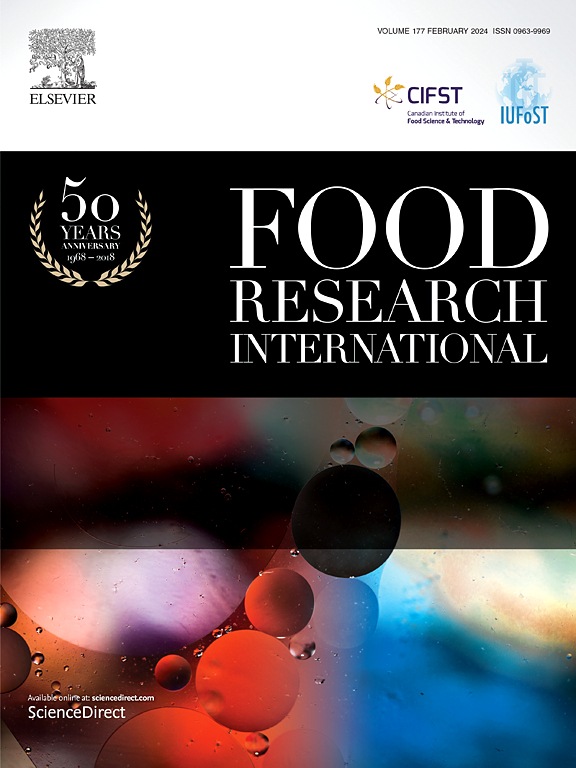Development of a saltiness evaluation system for solid foods using a surface salinity meter: The impact of surface salt distribution and taste bud responses
IF 8
1区 农林科学
Q1 FOOD SCIENCE & TECHNOLOGY
引用次数: 0
Abstract
Accurately assessing saltiness perception in solid foods is essential for the development of low-sodium foods that maintain saltiness despite possessing a lower sodium content. This study aimed to develop a practical system for evaluating human-perceived saltiness during oral processing, particularly when food was initially placed on the tongue. As a basis for system design, sensory evaluations demonstrated that higher local salt concentrations (inhomogeneous distribution) on the tongue significantly enhanced perceived saltiness intensity compared to a homogeneous distribution, despite equal total salt content. These findings suggest that the saltiness intensity is determined by the strongest response from taste buds in fungiform papillae, which act as independent taste sensors on the tongue, rather than by overall or average response. Based on this understanding, a method was developed to evaluate saltiness intensity, in which the surface salt distribution of a food sample was first transferred onto moistened filter paper. The saltiness intensity was then estimated from the maximum salt concentration on the filter paper using a surface salinity meter containing multiple salt sensors. This approach also enabled qualitative assessment of the saltiness when food was compressed against the tongue by measuring the maximum surface salinity under applied pressure. Unlike conventional saltiness sensors, this system offers a practical method for evaluating solid food saltiness. It also contributes to the development of low-sodium foods by strategically altering surface salt distribution to enhance the perception of saltiness, making it an important tool for use in the food industry.

基于表面盐度计的固体食品咸度评价系统的开发:表面盐分布和味蕾反应的影响
准确评估固体食物的咸味感知对于开发低钠食品至关重要,尽管钠含量较低,但仍能保持咸味。本研究旨在开发一种实用的系统来评估人类在口腔加工过程中感受到的咸味,特别是当食物最初放在舌头上时。作为系统设计的基础,感官评价表明,尽管总盐含量相同,但舌头上较高的局部盐浓度(不均匀分布)比均匀分布显著增强了感知的咸味强度。这些发现表明,咸味的强度是由真菌状乳头的味蕾的最强反应决定的,而不是由总体或平均反应决定的。真菌状乳头是舌头上独立的味觉传感器。基于这一认识,开发了一种评估盐强度的方法,其中首先将食品样品的表面盐分布转移到湿润的滤纸上。然后使用含有多个盐传感器的表面盐度计从滤纸上的最大盐浓度估计盐强度。这种方法还可以通过测量施加压力下食物表面的最大盐度,对食物在舌头上被压缩时的咸度进行定性评估。与传统的盐度传感器不同,该系统提供了一种评估固体食物盐度的实用方法。它还有助于低钠食品的发展,通过战略性地改变表面盐的分布,以增强咸味的感觉,使其成为食品工业中使用的重要工具。
本文章由计算机程序翻译,如有差异,请以英文原文为准。
求助全文
约1分钟内获得全文
求助全文
来源期刊

Food Research International
工程技术-食品科技
CiteScore
12.50
自引率
7.40%
发文量
1183
审稿时长
79 days
期刊介绍:
Food Research International serves as a rapid dissemination platform for significant and impactful research in food science, technology, engineering, and nutrition. The journal focuses on publishing novel, high-quality, and high-impact review papers, original research papers, and letters to the editors across various disciplines in the science and technology of food. Additionally, it follows a policy of publishing special issues on topical and emergent subjects in food research or related areas. Selected, peer-reviewed papers from scientific meetings, workshops, and conferences on the science, technology, and engineering of foods are also featured in special issues.
 求助内容:
求助内容: 应助结果提醒方式:
应助结果提醒方式:


